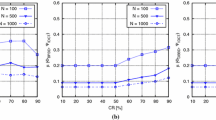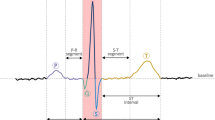Abstract
Measurements of magnetocardiogram (MCG) are commonly contaminated by different types of artifacts like breathing, power line interference and subject’s movement, out of which artifact due to breathing is unavoidable. This breathing artifact is mainly caused by movement of the chest of the subject during respiration and the consequent changes of the distance between the superconducting quantum interference device (SQUID) sensors (used for recording the MCG signal) and the subject (lying in a supine position under the cryostat housing the SQUID sensors); because of this, the measured MCG signal is a superposition of the true MCG signal of cardiac origin and the breathing related artifact. In most previous works, the suppression of baseline wander artifact was implemented by using digital filters, wavelet based technique, empirical mode decomposition (EMD) and ensemble empirical mode decomposition (EEMD). We present here a novel approach for effective suppression of breathing related baseline wander artifacts by acquiring the MCG data contaminated by the breathing artifact simultaneously with the experimental recording of the actual breathing pattern of the subject using a temperature sensor. The temperature sensor monitors the very slight change in temperature that occurs near the nostril during inhalation and exhalation, and this data is used for the subsequent elimination of the breathing artifact from the contaminated MCG by using the regression approach. We illustrate the method and compare its performance with other conventional approaches for the suppression of baseline wander in the measurement of MCG using single channel data. This is the first time that a breathing sensor has been employed for the suppression of breathing related baseline wander artifact. Experimental results reveal the superiority of the proposed approach in suppression of the breathing related base-line wander artifact with the important advantage that the algorithm used for the suppression uses the actual breathing data derived from an experimental input.






Similar content being viewed by others
References
Jian Lin, L., Kuan Tang, F., Hua, N., & Lu, H. (2011). Contrast between magnetocardiography and electrocardiography for the early diagnosis of coronary artery disease in patients with acute chest pain. In M. Alan, D. Willem, P. Laguna, G. Moody, A. Sims, & D. Zheng (Eds.), Computing in Cardiology (pp. 641–643). New York: IEEE.
Ha, T., Kim, K., Lim, S., Yu, K. K., & Kwon, H. (2015). Three-dimensional reconstruction of a cardiac outline by magnetocardiography. IEEE Transactions on Biomedical Engineering, 62(1), 60–69. doi:10.1109/TBME.2014.2336671.
Gustafson, K. M., & Popescu, E. A. (2016). Fetal assessment using biomagnetometry: Neurobehaviors, cardiac autonomic control, and research applications. In R. Nadja, & S. K. Barbara (Eds.), Fetal Development (pp. 453–480). New York: Springer.
Yoshida, K., Ogata, K., Inaba, T., Nakazawa, Y., Ito, Y., Yamaguchi, I., et al. (2015). Ability of magnetocardiography to detect regional dominant frequencies of atrial fibrillation. Journal of Arrhythmia, 31(6), 345–351.
Fenici, R. R., Romani, G. L., & Ern´e, S. N. (1983). High-resolution magnetic measurements of human cardiac electrophysiological events. Il Nuovo Cimento D, 2(2), 231–247. doi:10.1007/BF02455927.
Simson, M. B. (1983). Clinical application of signal averaging. Cardiology Clinics, 1(1), 109–119.
Senthilnathan, S., Chandrasekaran, P., Narayanan, M., Patel, R., Katholil, G., Janawadkar, M. P., et al. (2012). Enhancing the reliability in the noninvasive measurement of the his bundle magnetic field using a novel signal averaging methodology. Annals of Noninvasive Electrocardiology, 17(3), 186–194. doi:10.1111/j.1542-474X.2012.00523.x.
Lin, J. C. (2005). Advances in electromagnetic fields in living systems (Vol. 4). New York: Springer.
Fasano, A., & Villani, V. (2013). Baseline wander removal in ECG and AHA recommendations. In A. Murray, D. Willem, L. Pablo, M. George, & Z. Dingchang (Eds.), Computing in Cardiology Conference (CinC) (pp. 1171–1174). New York: IEEE.
Egila, M. G., El-Moursy, M. A., El-Hennawy, A. E., El-Simary, H. A., Zaki, A. (2016). FPGA-based electrocardiography (ECG) signal analysis system using least-square linear phase finite impulse response (FIR) filter. Journal of Electrical Systems and Information Technology. doi: 10.1016/j.jesit.2015.07.001. http://www.sciencedirect.com/science/article/pii/S2314717216300125.
Dong, Y., Shi, H., Luo, J., Fan, G., & Zhang, C. (2010). Application of wavelet transform in MCG signal denoising. Modern Applied Science, 4(6), 20–24.
Arvinti-Costache, B., Costache, M., Nafornita, C., Isar, A., Stolz, R., Toepfer, H. (2011). A wavelet based baseline drift correction method for fetal magnetocardiograms. New circuits and systems conference (NEWCAS), 2011 IEEE 9th International (pp. 109–112). Doi: 10.1109/NEWCAS.2011.5981231.
Pal, S., & Mitra, M. (2012). Empirical mode decomposition based ECG enhancement and QRS de- tection. Computers in Biology and Medicine, 42(1), 83–92.
Rajani Kumari, L. V., Padma Sai, Y., Balaji, N. Microelectronics, electromagnetics and telecommunications: Proceedings of ICMEET 2015, Springer India, New Delhi, 2016, Ch. ECG Signal Preprocessing Based on Empirical Mode Decomposition (pp. 673–679). doi: 10.1007/978-81-322-2728-1_64. http://dx.doi.org/10.1007/978-81-322-2728-1_64.
Mariyappa, N., Sengottuvel, S., Parasakthi, C., Gireesan, K., Janawadkar, M. P., Radhakrishnan, T. S., et al. (2014). Baseline drift removal and denoising of MCG data using EEMD: Role of noise amplitude and the thresholding effect. Medical Engineering and Physics, 36(10), 1266–1276.
Digital temperature sensor TMP102 (2015). http://www.ti.com.cn/cn/lit/ds/symlink/tmp102.pdf.
Teikari, P., Najjar, R. P., Malkki, H., Knoblauch, K., Dumortier, D., Gronfier, C., et al. (2012). An inexpensive Arduino-based LED stimulator system for vision research. Journal of Neuroscience Methods, 211(2), 227–236.
Kornuta, J. A., Nipper, M. E., & Dixon, J. B. (2013). Low-cost microcontroller platform for studying lymphatic biomechanics in vitro. Journal of Biomechanics, 46(1), 183–186.
Arduino due (2013). http://www.arduino.cc/en/Main/arduinoBoardDue.
Janawadkar, M. P., Radhakrishnan, T. S., Gireesan, K., Parasakthi, C., Sengottuvel, S., Patel, R., et al. (2010). SQUID based measurement of biomagnetic fields. Current Science, 99(1), 36–45.
P´erez, F., & Granger, B. E. (2007). Ipython: A system for interactive scientific computing. Computing in Science and Engineering, 9(3), 21–29.
Kara, S., & Okandan, M. (2007). Atrial fibrillation classification with artificial neural networks. Pattern Recognition, 40 (11), 2967–2973. doi: 10.1016/j.patcog. 2007.03.008. http://www.sciencedirect.com/science/article/pii/S0031320307001161.
Hamprecht, F. A., Achleitner, U., Krismer, A. C., Lindner, K. H., Wenzel, V., Strohmenger, H.-U., Thiel, W., van Gunsteren, W. F., Amann, A. (2001). Fibrillation power, an alternative method of {ECG} spectral analysis for prediction of countershock success in a porcine model of ventricular fibrillation. Resuscitation 50(3), 287–296. doi: 10.1016/S0300-9572(01)00359-8. http://www.sciencedirect.com/science/article/pii/S0300957201003598.
Patel, R., Janawadkar, M. P., Sengottuvel, S., Gireesan, K., & Radhakrishnan, T. S. (2016). Suppression of eye-blink associated artifact using single channel eeg data by combining cross-correlation with empirical mode decomposition. IEEE Sensors Journal, 16(18), 6947–6954. doi:10.1109/JSEN.2016.2591580.
Corbishley, P., & Rodriguez-Villegas, E. (2008). Breathing detection: Towards a miniaturized, wear- able, battery-operated monitoring system. IEEE Transactions on Biomedical Engineering, 55(1), 196–204. doi:10.1109/TBME.2007.910679.
Blanco-Velasco, M., Weng, B., & Barner, K. E. (2008). ECG signal denoising and baseline wander correction based on the empirical mode decomposition. Computers in Biology and Medicine, 38(1), 1–13.
Reddy, G. U., Muralidhar, M., & Varadarajan, S. (2009). ECG De-Noising using improved threshold- ing based on wavelet transforms. International Journal of Computer Science and Network Security, 9(9), 221–225.
Acknowledgements
Authors thank Dr. G. Amarendra, Director MSG, IGCAR for his valuable support throughout this research work. The authors would also like to thank the editor and all the reviewers for their valuable comments and suggestions to improve the content of the paper. The study has been possible by the support of the Department of Science and Technology, Government of India under a project to develop MCG and MEG systems at IGCAR.
Author information
Authors and Affiliations
Corresponding author
Ethics declarations
Ethical Approval
This study was carried out on volunteers, with informed consent obtained from them prior to commencing the collaborative work between the Jawaharlal Institute of Postgraduate Medical Education and Research (JIPMER), Pondicherry and the Indira Gandhi Centre for Atomic Research (IGCAR), Kalpakkam.
Rights and permissions
About this article
Cite this article
Patel, R., Gireesan, K., Sengottuvel, S. et al. Suppression of Baseline Wander Artifact in Magnetocardiogram Using Breathing Sensor. J. Med. Biol. Eng. 37, 554–560 (2017). https://doi.org/10.1007/s40846-017-0274-9
Received:
Accepted:
Published:
Issue Date:
DOI: https://doi.org/10.1007/s40846-017-0274-9




